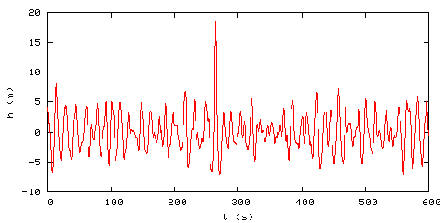The ocean is so full of mysteries that it sometimes feels almost unknowable. How can we ever fully understand something so wide, deep, and dark?
But of course, all of that mystery just means that there's always something fascinating to discover.
One thing that researchers are learning more and more about is rogue waves.
A rogue wave is a wave that is at least twice the height of the waves around it. Even though sailors and explorers talked about them for centuries, many on dry land refused to believe they existed. It wasn't until 1995 that scientists finally confirmed them.
And now we have evidence of the most extreme rogue wave ever recorded. A massive wave near Ucluelet, Vancouver Island from November 2020 that was 17.6 metres (58 feet) high. That's around the height of a five-storey building!
Why are rogue waves so tricky?

This chart shows the Draupner wave, which was recorded in 1995. It was the first scientific proof of a rogue wave. At 25.6 m (84 ft), it was about twice the height of the surrounding waves. (Getty Embed)
A big reason why rogue waves had always been so challenging to confirm? They're impossible to predict!
Waves are energy that is being carried through a body of water. It is common for waves to vary a little in size from one to the next, but they are all generally in a similar size range. And when they change in size, it is something that happens in groups. Having one wave on its own that is dramatically larger than anything else surrounding it is extremely rare.
But that is exactly what a rogue wave is. A lone, large wave. So being around to record it is a real challenge. Unlike a big stormy sea, you don't really know it's coming, and it comes and goes by quickly.
It's not just the height
What makes a rogue wave a rogue wave is not necessarily its height, but how high it is compared to what is around it.
Take the Ucluelet wave, which is the most extreme rogue wave ever recorded. A 17-meter wave is very big, but it's nowhere near the biggest waves out there. But this rogue wave was three times the height of the waves that surrounded it. That's the biggest difference ever recorded!
It's also baffling scientists, who are still trying make sense of how these waves are made.
Fortunately for them, the Ucluelet wave was recorded—not by cameras, but by sensors on aboard a buoy in the water. Now after a bunch of research, scientists have released a computer modeling video of the movement of the water before, during, and after this wave.
You can have a look at the video below. We're pretty happy we weren't around to 'sea' this wave in person!
 The open sea can be an unpredictable place. (ID 19984134 © Irabel8 | Dreamstime.com)
The open sea can be an unpredictable place. (ID 19984134 © Irabel8 | Dreamstime.com)









